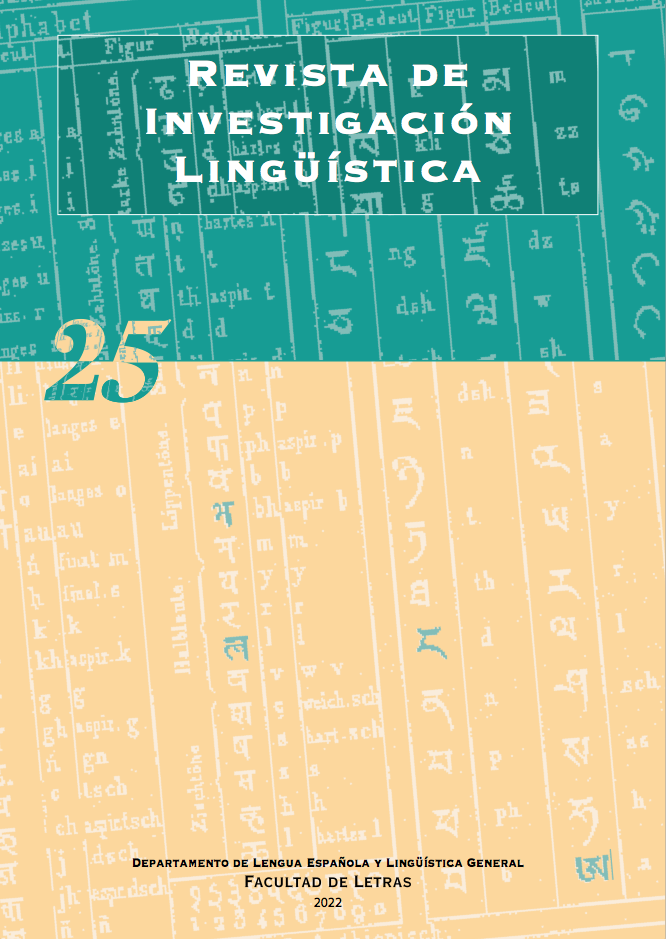Self-centered discourse in four university classes: a study based on speaking turns
Abstract
This study analyses speaking turns in the communicative process of university classes. Four pedagogical speeches were observed for fifty minutes and audio-recorded, and speaking turns were then categorised. Next, the information was interpreted applying the tenets of Discourse Analysis. The results derived from the corpus analysis show an interactive pattern without significant alterations: the lecturer explains and asks, the student listens and responds. The conclusions revolve around the characteristics of self-centered discourse and the need to transform academic environments through interactive, reflective and open higher-education pedagogical discourse.
Downloads
-
Abstract632
-
PDF (Español (España))668
References
ALBORNOZ MUÑOZ, Natalia y Rodrigo CORNEJO CHÁVEZ (2017): «Discursos docentes sobre el vínculo con sus estudiantes: tensiones, enfrentamiento y distancia», Estudios Pedagógicos, 43(2), pp. 7-25. DOI: http://dx.doi.org/10.4067/S0718-07052017000200001.
BERNSTEIN, Basil (1990): Class, codes and control, vol. IV: The structuring of pedagogic discourse, Londres, Routledge.
BRIZ, Antonio (2000): «Las unidades de la conversación», RILCE, 16, pp. 225-246. DOI: https://doi.org/10.15581/008.16.26795.
BROWN, Roger y Albert GILMAN (1960): «The Pronouns of Power and Solidarity», Thomas A. Sebeok (ed.), Style in Language, Massachusetts, MIT Press, pp. 253-277.
CALSAMIGLIA, Helena y Amparo TUSÓN (2002): Las cosas del decir, Barcelona, Editorial Ariel.
CAMARGO FERNÁNDEZ, Laura y Beatriz MÉNDEZ GUERRERO (2013): «Los actos silenciosos en la conversación de las jóvenes españolas. Estudio sociolingüístico», Lingüística en la Red, 11, pp. 1-23. En línea: <https://ebuah.uah.es/dspace/handle/10017/23600> [30/07/2022].
CESTERO MANCERA, Ana M.ª (2000): El intercambio de turnos de habla en la conversación (Análisis sociolingüístico), Alcalá de Henares, Servicio de Publicaciones de la Universidad de Alcalá.
CESTERO MANCERA, Ana M.ª (2017): «La comunicación no verbal», en Ana M.ª Cestero Mancera e Inmaculada Penadés Martínez (eds.), Manual del profesor de ELE, Universidad de Alcalá, Servicio de Publicaciones, pp. 1051-1122.
GALLARDO PAÚLS, Beatriz (1993): «La transición entre turnos conversacionales: silencios, solapamientos e interrupciones», Contextos, 21-22, pp. 189-220.
GONZÁLEZ, Beatriz y Aníbal LEÓN (2009): «Interacción verbal y socialización cognitiva en el aula de clase», Acción pedagógica, 18, pp. 30-41. En línea: <http://www.saber.ula.ve/handle/123456789/29540> [23/07/2021].
MONTENEGRO MAGGIO, Helena y Lorena MEDINA MORALES (2014): «Polifonía discursiva y procesos de cambio en los formadores docentes: ¿Qué voces movilizan sus prácticas de enseñanza?», Estudios Pedagógicos, 40, pp. 161-182. DOI: http://dx.doi.org/10.4067/S0718-07052014000200010.
MUSSELMAN SHANK, Regina (2002): «Las estrategias para la construcción del turno en la conversación. Datos del español de México», tesis para obtener el grado de Doctor en Lingüística, México, El Colegio de México. En línea: <https://repositorio.colmex.mx/concern/theses/fn106z16k?locale=es> [15/08/2021].
PÉREZ ESCLARÍN, Antonio (2007): Educar valores y el valor de educar. Parábolas, Caracas, San Pablo.
PIAGET, Jean (2001): La representación del mundo en el niño, Madrid, Morata.
SACKS, Harvey, Emanuel A. SCHEGLOFF y Gail JEFFERSON (1974): «A simplest systematics for the organization of turn-taking in conversation», Language, 50(4), pp. 696-735. DOI: https://doi.org/10.1353/lan.1974.0010.
SINCLAIR, John McHardy y Malcolm COULTHARD (1975): Toward an Analysis of Discourse. The English used by teachers and pupils, Londres, Oxford University Press.
SOLAR R., María Inés y Carlos DÍAZ L. (2009): «Los procesos de enseñanza-aprendizaje en el aula universitaria: una mirada desde las creencias de académicos de trabajo social y periodismo», Estudios Pedagógicos, 35(1), pp. 181-197. DOI: http://dx.doi.org/10.4067/S0718-07052009000100011.
TORREALBA, María (2004): «La interacción docente y el discurso pedagógico de la ironía», Educere. Revista Venezolana de Educación, 26, pp. 355-360. En línea: <http://www.saber.ula.ve/handle/123456789/19899> [18/05/2021].
TUSÓN, Amparo (1997): Análisis de la conversación, Barcelona, Ariel Practicum.
UCLA = Universidad Centroccidental Lisandro Alvarado: Políticas de docencia de pregrado (2004). En línea: <http://www.ucla.edu.ve/comision/curriculo/Politicas_de_Docencia.pdf> [08/07/2020].
VAN DIJK, Teun A. (2000): El discurso como estructura y proceso, vol. 1: Estudios del discurso: intorducción multidisciplinaria, Barcelona, Gedisa.
VÁZQUEZ, Graciela (coord.) (2001): Guía didáctica del discurso académico escrito. ¿Cómo se escribe una monografía?, Madrid, Edinumen.
VÁZQUEZ, Graciela (2007): «Un análisis didáctico del discurso académico español como contribución a la movilidad estudiantil europea», en Anna Escofet Roig et al. (eds.), Español para Fines Específicos. Actas del III Congreso Internacional de Español para Fines Específicos, Utrecht, noviembre de 2006, Secretaria General Técnica de Ministerio de Educación y Ciencia. En línea: <https://cvc.cervantes.es/ensenanza/biblioteca_ele/ciefe/pdf/03/cvc_ciefe_03_0013.pdf> [15/06/2021].
Copyright (c) 2022 Journal of Linguistic Research

This work is licensed under a Creative Commons Attribution-NonCommercial-NoDerivatives 4.0 International License.
The works published in this magazine are subject to the following terms:
1. The Publications Service of the University of Murcia (the publisher) preserves the economic rights (copyright) of the published works, and favors and allows the reuse of same under the license of use indicated in point 2.
2. The papers are published in the electronic edition of the magazine under a Creative Commons Attribution-NonCommercial-NoDerivative 3.0 Spain license (legal text). Papers may be copied, used, disseminated, transmitted and publicly exhibited if the following requirements are met: i) The authorship and the original source of its publication (magazine, editorial and URL of the work) must be cited; ii) The works cannot be used for commercial purposes; iii) The existence and specifications of this user license must be explicitly mentioned.
3. Self-archiving conditions. Authors can electronically disseminate pre-print versions (version before being evaluated) and / or post-print versions (version evaluated and accepted for publication). This makes possible its circulation and diffusion earlier and with it a possible increase in its citation and reach among the academic community. RoMEO color: green.









